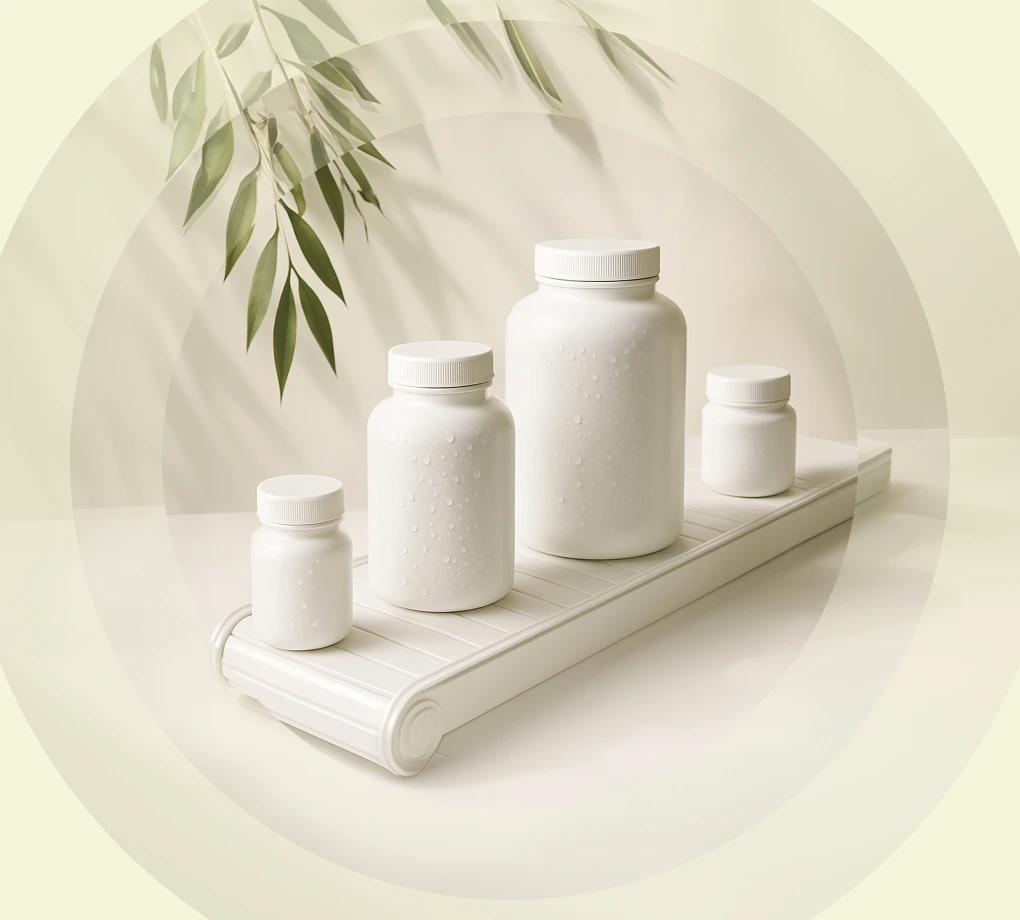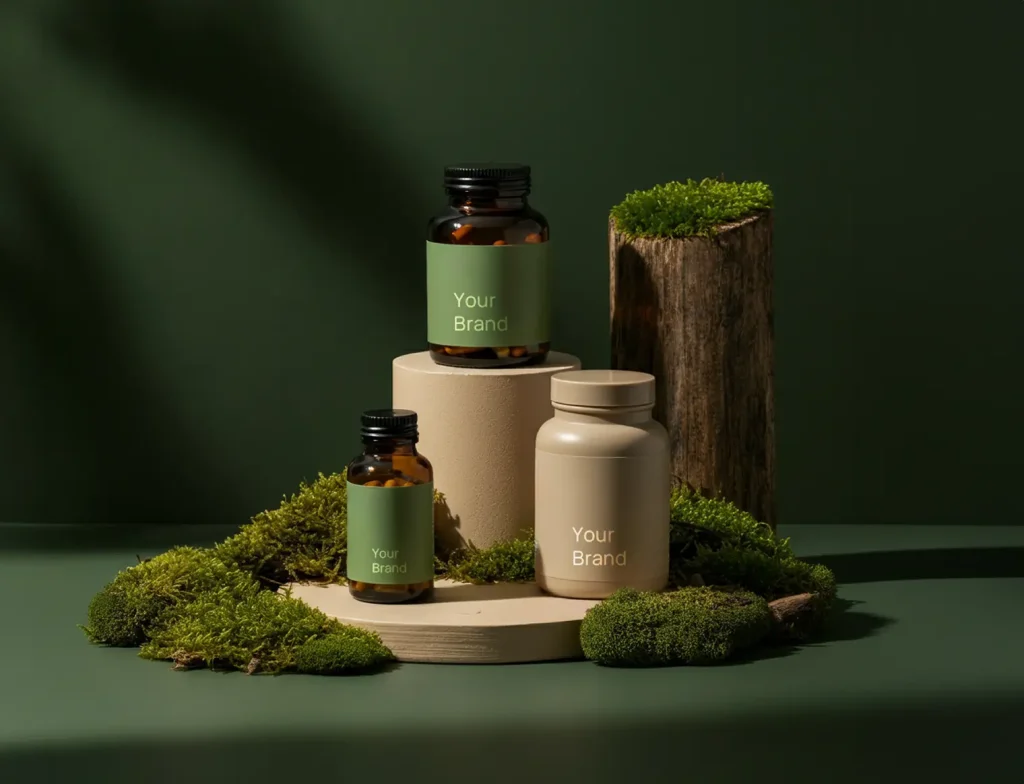Labor
Skilled technicians and operators must oversee the setup, run the line, and monitor quality. Their work hours are largely fixed, so when spread over fewer units, the labor cost per item is much higher.

Minimum order quantity (MOQ) is the smallest batch a manufacturer will produce in a run. For example, many supplement manufacturers set MOQs at around 1,000 units, while low-MOQ options may start at 250–500 units. Startups often choose smaller MOQs to test product-market fit before committing to larger volumes — which is why many new brands begin with white-label supplements, allowing them to launch quickly without taking on large production risks.
Although MOQs might seem arbitrary, in reality, they are shaped by a mix of:

For brand owners, MOQs determine your launch speed, capital outlay, and competitive edge.
Now let’s take a look at some of the factors that may affect your MOQs.
Your minimum order quantity (MOQ) is not just a factory number — it directly ties into your brand strategy, stage of growth, and target audience. The right MOQ can determine whether you’re testing ideas quickly, scaling for profit, or building exclusivity around your products.
For startups
New brands entering the market often face limited budgets and high uncertainty. Lower MOQs (around 250–500 units) allow founders to minimize upfront investment while testing multiple product ideas or formulations. This flexibility is crucial for gathering early customer feedback and validating demand before committing to larger production runs. Small MOQs also reduce the risk of excess inventory, which can tie up capital and create storage challenges.
For established or cost-sensitive brands
Once a brand has traction and predictable demand, higher MOQs (e.g., 5,000 units or more) can be strategically advantageous. Larger batches spread out setup and manufacturing costs, leading to significantly lower per-unit expenses. This boosts profit margins and provides room for competitive pricing in crowded markets. Cost-sensitive brands, such as those competing in the mid-market or mass retail, often rely on these economies of scale to remain price-competitive while maintaining quality.
For luxury or niche brands
On the opposite end of the spectrum, luxury and niche players may intentionally choose smaller production runs to reinforce their positioning. Producing in limited quantities creates a sense of scarcity, which not only protects exclusivity but also justifies premium pricing. Customers of niche brands are often willing to pay more for products that feel rare, artisanal, or highly specialized. In this case, a higher per-unit cost is offset by elevated brand perception and stronger margins per sale.
Manufacturers incur fixed costs regardless of batch size. No matter how small or large the production run, certain steps in the process carry costs that don’t change with volume:
Machine setup
Each production run requires calibration, cleaning, and sometimes even mold or tooling adjustments before it can begin. These steps are essential for consistency and safety, but they take the same amount of time whether the batch is 500 or 5,000 units.
For luxury or niche brands
On the opposite end of the spectrum, luxury and niche players may intentionally choose smaller production runs to reinforce their positioning. Producing in limited quantities creates a sense of scarcity, which not only protects exclusivity but also justifies premium pricing. Customers of niche brands are often willing to pay more for products that feel rare, artisanal, or highly specialized. In this case, a higher per-unit cost is offset by elevated brand perception and stronger margins per sale.
Skilled technicians and operators must oversee the setup, run the line, and monitor quality. Their work hours are largely fixed, so when spread over fewer units, the labor cost per item is much higher.
Safety testing, compliance verification, and in-process inspections are mandatory for every run. Regulatory requirements don’t scale down with volume, meaning a small batch still demands the full scope of checks and documentation.
Because these costs are distributed across all units in the batch, small production runs inevitably drive up the cost per unit. For instance, if €1,000 in setup and compliance costs are applied to 500 units, that adds €2 per unit. Spread across 5,000 units, the same fixed expense only adds €0.20 per unit.
Contact us to learn more about Merywood’s team, and how we can empower your business.

MOQs often depend directly on how raw materials are purchased and managed during production. Unlike packaging or logistics, where costs are about handling and transport, ingredients themselves dictate minimums because of the way suppliers sell them:
Bulk purchasing
Manufacturers typically buy ingredients such as vitamins, minerals, or herbal extracts in large lots. A single drum of powder might hold 25–50 kg, and suppliers rarely split these orders into smaller portions. This means that even if your formula requires only 5 kg for a small run, the manufacturer may still need to buy the whole drum.
When batches are too small, the risk of unused or expired raw material increases. Many active ingredients have limited shelf lives once opened, so leftover material may not be usable for the next run. This loss drives manufacturers to set MOQs that make ingredient use more efficient.
Complex formulations often require larger MOQs due to the constraints of mixing equipment capacity and ingredient ratios. For example, a minimum batch of a capsule blend may range between 300–700 kg, which translates into roughly 500,000 filled capsules. Producing anything smaller can be technically inefficient or wasteful.
Beyond the raw ingredients, additional resources like specialized equipment, mixing time, and lab testing also tie up production capacity. Manufacturers prefer larger runs that justify dedicating these resources to your project.
In short, ingredient sourcing sets a natural floor for MOQs: brands must order enough units to match bulk purchasing practices and avoid waste, which is why supplement formulas often come with higher minimums than packaging or labeling alone might suggest.
Packaging and regulatory compliance are two major factors shaping MOQs. Both carry costs that don’t scale down with smaller orders:
The price per unit decreases as volumes grow. For example, ordering 5,000 jars might bring the cost down to €2.50 each, while ordering only 500 jars of the same type could raise the cost to €6.50 per unit. Bulk runs allow manufacturers to spread setup and tooling costs across more units.
Stability, safety, and shelf-life testing must be carried out for every new product, regardless of how many units are produced. These laboratory tests often cost thousands of euros, and when allocated across a small batch, the per-unit impact is substantial.
Each packaging run requires machine calibration, label adjustments, and quality checks. Running frequent small batches means repeating this process again and again, which is both time-consuming and expensive compared to one larger production run.
At first glance, a low minimum order quantity (MOQ) looks attractive — less money tied up in stock, less risk. But in practice, very small runs often push unit costs so high that margins disappear.
Example calculation:
Total production cost is €12,500 (€2.50 per jar). If you sell each jar for €10, your gross margin per unit is €7.50 — a healthy 75%.
Total production cost is €3,250 (€6.50 per jar). Selling at the same €10 price leaves just €3.50 margin per unit — only 35%. After marketing, logistics, and VAT, profit may even turn negative.
This is why manufacturers usually allow very low MOQs only for test batches. Once demand is proven, scaling up is expected — otherwise the economics simply don’t work.
At first glance, a low minimum order quantity (MOQ) looks attractive:
But in reality, very small production runs often kill your profit margins because the cost per unit rises sharply.
What This Means in Practice
With a 5,000-unit order, you keep €7.50 profit per jar. Even after marketing, logistics, and VAT, your margins remain healthy.
With a 500-unit order, the margin drops to just €3.50 per jar. Once you add advertising, shipping, and taxes, profits can disappear — or even turn negative.
Low MOQs make sense only for test batches. Manufacturers offer them so you can validate demand. But once sales are proven, scaling up is the only way to make the business profitable.
MOQs are ultimately about balancing strategy, efficiency, and cost. Starting small — often at 250–500 units — helps validate a product with minimal risk. Once demand is confirmed, increasing volume lowers unit costs and strengthens margins. At the same time, MOQs protect manufacturer viability and create a framework that enables brands to scale more sustainably and strategically.
